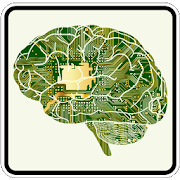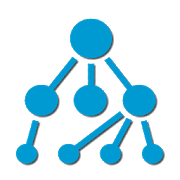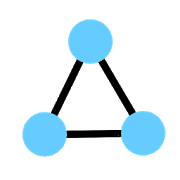Top 17 Apps Similar to Extreme Learning Machine
Neural network fuzzy systems 5.4
The app is a complete free handbook of Neural network,fuzzysystems which cover important topics, notes, materials, news&blogs on the course. Download the App as a reference material&digital book for Brain and Cognitive Sciences, AI,computerscience, machine learning, knowledge engineering programs°ree courses. This useful App lists 149 topicswithdetailed notes, diagrams, equations, formulas &coursematerial, the topics are listed in 10 chapters. The app ismusthave for all the engineering science students&professionals. The app provides quick revision andreferenceto the important topics like a detailed flash card notes,it makesit easy & useful for the student or a professional tocover thecourse syllabus quickly before an exams or interviewforjobs. Track your learning, set reminders, edit thestudymaterial, add favorite topics, share the topics onsocialmedia. You can also blog about engineeringtechnology,innovation, engineering startups, college researchwork,institute updates, Informative links on course materials&education programs from your smartphone or tablet orathttp://www.engineeringapps.net/. Use this usefulengineeringapp as your tutorial, digital book, a reference guidefor syllabus,course material, project work, sharing your views ontheblog. Some of the topics Covered in the app are: 1)RegisterAllocation and Assignment 2) The Lazy-Code-Motion Algorithm3)Matrix Multiply: An In-Depth Example 4) Rsa topic 1 5)Introductionto Neural Networks 6) History of neural networks 7)Networkarchitectures 8) Artificial Intelligence of neural network9)Knowledge Representation 10) Human Brain 11) Model of a neuron12)Neural Network as a Directed Graph 13) The concept of timeinneural networks 14) Components of neural Networks 15)NetworkTopologies 16) The bias neuron 17) Representing neurons 18)Orderof activation 19) Introduction to learning process 20)Paradigms oflearning 21) Training patterns and Teaching input 22)Usingtraining samples 23) Learning curve and error measurement24)Gradient optimization procedures 25) Exemplary problems allowfortesting self-coded learning strategies 26) Hebbian learningrule27) Genetic Algorithms 28) Expert systems 29) Fuzzy SystemsforKnowledge Engineering 30) Neural Networks for KnowledgeEngineering31) Feed-forward Networks 32) The perceptron,backpropagation andits variants 33) A single layer perceptron 34)Linear Separability35) A multilayer perceptron 36) ResilientBackpropagation 37)Initial configuration of a multilayer perceptron38) The 8-3-8encoding problem 39) Back propagation of error 40)Components andstructure of an RBF network 41) Informationprocessing of an RBFnetwork 42) Combinations of equation system andgradient strategies43) Centers and widths of RBF neurons 44)Growing RBF networksautomatically adjust the neuron density 45)Comparing RBF networksand multilayer perceptrons 46) Recurrentperceptron-like networks47) Elman networks 48) Training recurrentnetworks 49) Hopfieldnetworks 50) Weight matrix 51) Autoassociation and traditionalapplication 52) Heteroassociation andanalogies to neural datastorage 53) Continuous Hopfield networks54) Quantization 55)Codebook vectors 56) Adaptive Resonance Theory57) KohonenSelf-Organizing Topological Maps 58) UnsupervisedSelf-OrganizingFeature Maps 59) Learning Vector QuantizationAlgorithms forSupervised Learning 60) Pattern Associations 61) TheHopfieldNetwork 62) Limitations to using the Hopfield network Eachtopic iscomplete with diagrams, equations and other forms ofgraphicalrepresentations for better learning and quickunderstanding. Neural network, fuzzy systems is part of Brainand CognitiveSciences, AI, computer science, machine learning,electrical,electronics, knowledge engineering education courses andtechnologydegree programs at various universities.
Neural Network Simulator 1.5.1
Ever wanted to fiddle with your brain?Thisneural network simulator allows you to build small circuitsofbrain cells and watch their activity. The simulation is designedtosimulate realistic neurons and neural connections. Yourphone'ssensors even function as inputs for the network. Try yourhand atbuilding your very own mini-brain.
Artificial Intelligence 5.4
The app is a complete free handbookofArtificial Intelligence with diagrams and graphs. It is partofComputer or software engineering education which bringsimportanttopics, notes, news & blog on the subject. The Appserves as aquick reference guide on this engineering subject.It covers more than 140 topics of Artificial Intelligenceindetail. The topics are divided into 5 units.Each topic is complete with diagrams, equations and otherformsof graphical representations for better learning andquickunderstanding. The App will provide faster learning andquickrevisions on the subject.Some of the topics Covered in this application are:1. Turing test2. Introduction to Artificial Intelligence3. History of AI4. The AI Cycle5. Knowledge Representation6. Typical AI problems7. Limits of AI8. Introduction to Agents9. Agent Performance10. Intelligent Agents11. Structure Of Intelligent Agents12. Types of agent program13. Goal based Agents14. Utility-based agents15. Agents and environments16. Agent architectures17. Search for Solutions18. State Spaces19. Graph Searching20. A Generic Searching Algorithm21. Uninformed Search Strategies22. Breadth-First Search23. Heuristic Search24. A∗ Search25. Search Tree26. Depth first Search27. Properties of Depth First Search28. Bi-directional search29. Search Graphs30. Informed Search Strategies31. Methods of Informed Search32. Greedy Search33. Proof of Admissibility of A*34. Properties of Heuristics35. Iterative-Deepening A*36. Other Memory limited heuristic search37. N-Queens eample38. Adversarial Search39. Genetic Algorithms40. Games41. Optimal decisions in Games42. minimax algorithm43. Alpha Beta Pruning44. Backtracking45. Consistency Driven Techniques46. Path Consistency (K-Consistency)47. Look Ahead48. Propositional Logic49. Syntax of Propositional Calculus50. Knowledge Representation and Reasoning51. Propositional Logic Inference52. Propositional Definite Clauses53. Knowledge-Level Debugging54. Rules of Inference55. Soundness and Completeness56. First Order Logic57. Unification 58. Semantics59. Herbrand Universe60. Soundness, Completeness, Consistency, Satisfiability61. Resolution62. Herbrand Revisited63. Proof as Search64. Some Proof Strategies65. Non-Monotonic Reasoning66. Truth Maintenance Systems67. Rule Based Systems68. Pure Prolog69. Forward chaining70. backward Chaining71. Choice between forward and backward chaining72. AND/OR Trees73. Hidden Markov Model74. Bayesian networks75. Learning Issues76. Supervised Learning77. Decision Trees78. Knowledge Representation Formalisms79. Semantic Networks80. Inference in a Semantic Net81. Extending Semantic Nets82. Frames83. Slots as Objects84. Interpreting frames85. Introduction to Planning86. Problem Solving vs. Planning87. Logic Based Planning88. Planning Systems89. Planning as Search90. Situation-Space Planning Algorithms91. Partial-Order Planning92. Plan-Space Planning Algorithms93. Interleaving vs. Non-Interleaving of Sub-Plan Steps94. Simple Sock/Shoe Example95. Probabilistic Reasoning96. Review of Probability Theory97. Semantics of Bayesian Networks98. Introduction to Learning99. Taxonomy of Learning Systems100. Mathematical formulation of the inductivelearningproblem101. Concept Learning102. Concept Learning as Search103. Algorithm to Find a Maximally-Specific Hypothesis104. Candidate Elimination Algorithm105. The Candidate-Elimination Algorithm106. Decision Tree Construction107. Splitting Functions108. Decision Tree Pruning109. Neural Networks110. Artificial Neural Networks111. Perceptron112. Perceptron Learning
Neural Network 3D 1.0
virtual reality environment.Key Learning Concepts in the App:Neural NetworkNeuronBrainNeuroscienceSynapseDendriteThinkingSTEMMovementUse the Right joystick to moveUse the Left joystick to rotate and look aroundTouch any sign for informationFor ease of travel you can go through most objectsincludingthegroundAbout Virtual RealityVirtual Reality (VR) is a technology that allows us to stepinto3Dinteractive environments where everything is possible:visitingNewYork, exploring the human cell, flying through the SolarSystem,ortraveling back in time to Ancient Egypt. From a PC,Tablet,phone,or headset users have a first person, self-guidedexperiencewithconcepts. We step inside of a molecule to understanditsstructure.We travel through an iPhone to learn how it operates.Webecome apart of a subject; this is the magic of VR.For the complete list of 200+ VR learning programsinScience,Anatomy, World Landmarks, Astronomy, History,Technology,Art &Culture, Current Events, Geography, and NaturalFeatures,please goto http://www.sunrisevr.com/programsLesson PlansLesson Plans for virtual learning programs areavailableathttp://www.sunrisevr.com/programsTeachers: Classroom 3D DirectImagine a classroom where the world's most advancedlearningisdelivered to teachers every week, hours after itwascompleted.Free. This is instant access 3D, virtuallearningprograms based onthe most important topics of the week thatyou canshare with yourstudents. Classroom 3D Direct deliversweeklyprograms straight toyour email inbox complete with lessonplans,videos, and topicallinks to help you easily integrate 3D intoyourclass. One clicktakes your students into the virtual world. Tosignup for the freeClassroom 3D Direct, simply enter your emailaddressathttp://www.sunrisevr.com/classroom-3d-directAbout this AppSUNRISE Virtual Reality takes learning into3D.SUNRISE(www.sunrisevr.com) is the world leader invirtuallearning,providing easily accessed programs that featurelearningthrough 3Dgraphics and personal interaction. Click. Smile.Explore.It’s thateasy. Anyone can use programs free of charge.SUNRISEtakeslearning seriously: American children havenumerousandwell-documented deficiencies in many subjectareas,especiallyscience, technology, engineering, and math (STEM).Thecompany seesvirtual learning as an important part of thenationaleffort toimprove education and help students“UnderstandEverything.”Learning can be more.
Numerical Methods & Analysis 6.0
The app is a complete free handbook of NumericalMethods&Analysis which covers important topics, notes,materials &newson the course. Download the App as a referencematerial&digital book for Mathematics & mechanicalengineeringprograms& degree courses. The study is also usedextensivelyinArtificial intelligence, algorithms, real time systemsandmachinelearning. This useful App lists 77 topics withdetailednotes,diagrams, equations, formulas & course material,thetopics arelisted in 5 chapters. The app is must have for alltheengineeringscience students & professionals. The appprovidesquickrevision and reference to the important topics likeadetailedflash card notes, it makes it easy & useful forthestudent ora professional to cover the course syllabus quicklyjustbefore anexams or job interviews. Also get thehottestinternationalengineering & technology news on your apppoweredby Googlenews feeds. We have customised it so that you getregularupdateson subject from international/nationalcolleges,universities,research, industry, applications,engineering, tech,articles &innovation. This is the bestapplication to remainupdated on yourfav. subject. Use this usefulengineering app asyour educationtool, utility, tutorial, book, areference guide forsyllabus andexplore study course material,aptitude tests &project work.Track your learning, setreminders, edit, addfavourite topics,share the topics on socialmedia. Some of thetopics Covered inthis application are: 1.Solution of algebraic andtranscendentalequations 2. Methods ofsolving roots of polynomialequations 3.Initial Approximation for anIterative Procedure 4.Method of FalsePosition 5. Newton-RaphsonMethod 6. GeneralIteration Method 7.Convergence of the IterationMethods 8. Linearsystem of algebraicequations 9. Direct method forsolving linearsystem 10. Guasselimination method 11. Guass jordanmethod 12.Iterative Methods13. Gauss-Jacobi Iteration Method 14.Gauss-SeidelIteration Method15. Eigen value problems 16. Powermethod 17.Interpolation 18.Lagrange Interpolation 19. LinearInterpolation20. Quadraticinterpolation 21. Error of interpolation22. Divideddifferences23. Newton’s Divided Difference Interpolation24.InterpolationWith Evenly Spaced Points 25. Relationsbetweendifferences andderivatives 26. Newton’s forward differenceformula27. Newton’sBackward Difference Interpolation Formula 28.Splinefunction 29.Cubic Interpolation 30. Numerical Differentiation31.DerivativesUsing Newton’s Forward Difference Formula32.Derivatives UsingNewton’s Backward difference Formula33.Derivatives using DividedDifference Formula 34.NumericalIntegration and Integration RulesBased on Uniform MeshSpacing 35.Trapezium Rule 36. Error inTrapezium Rule 37. Compositetrapeziumrule 38. Simpson’s 1/3 Rule39. Error in Simpson’s 1/3 Rule40.Composite Simpson’s 1/3 Rule41. Simpsom’s 3/8 Rule 42.RombergMethod 43. Romberg method forthe trapezium rule 44. Rombergmethodfor the Simpson’s 1/3 Rule45. Gauss-Legendre IntegrationRules 46.Gauss one point rule(Gauss-Legendre one point rule) 47.Gauss Twopoint rule(Gauss-Legendre Two point rule) 48. Gauss Threepointrule(Gauss-Legendre Three point rule) 49. EvaluationofDoubleIntergral Using Trapezium Rule 50. Evaluation ofDoubleIntergralUsing Simpson’s rule 51. Introduction to InitialValueProblem forOrdinary Differential Equations 52. Reduction ofsecondorderequation to a first order system 53. Single Step Method54.Multistep Methods 55. Taylor series Method 56. Modified EulerorHeun’sMethods 57. Runge Kutta Methods Each topic iscompletewithdiagrams, equations and other forms ofgraphicalrepresentationsfor better learning and quickunderstanding.Numerical Methods& Analysis is part ofMathematics &mechanical engineeringeducation courses andtechnology degreeprograms of variousuniversities.
Emergent X 1.0
This app allows the user to interactively experiment withandvisualize the training of a single neuron (feature detector) inanunsupervised neural network. The user provides the online"trainingdata" via taking photos. Instructions: take photos and bepatient-- even small neural networks are computationally intensive!Thenetwork converges on the first "principal component" or mostoftenoccurring 2 x 2 feature pattern that multiple images shareincommon. This network implements only local learning rules: 1.Aneuron is competitive: if it frequently does not fire, itdecreasesits threshold to respond to stimuli with greater variance.2. Aneuron is thrifty: if it frequently fires, it increasesitsthreshold 3. When a neuron fires, it tunes its "weights" to moveina direction which will increase the likelihood of a similarpatterntriggering it in the future. Example: if a post synapticneuron wasresponding to a high amplitude signal, but now respondsto a loweramplitude signal (due to threshold decrease), its weightswill movetowards the lower amplitude signal. Network structure: 1.Inputlayer: 8 x 8 x 3 (3 color channels) 2. Convolutional layer: 2x 2 x3 ( 1 neuron with 12 synapses) 3. Activation Map: 7 x 7 x 1Note:Color channels are preprocessed to respond similarlyregardless oflighting.
TreeLogy 1.0
“Treelogy” is a mobile application, which can performleaf-basedtree identification among tree species in Turkey usingone pictureof a given leaf. There is only handful of applicationsinterestedin tree identification and they are designed primarilyfordetecting North American and European tree species. There isnoapplication which has a good performance and localizationsupportfor identifying tree species native to Turkey. This projectisaimed to fill this gap. While we are constructing thisapplication,we worked on supervised learning for classi- ficationtask. Wefocused on both Deep Learning (specifically DeepConvolutionalNeural Networks) and Support Vector Machines. Treeidentificationprocess uses leaf image features gathered from Caffe,aconvolutional neural network framework, and our imageprocessingmodule. After several experiments, we reached theoptimalclassification accuracy of 93.59% for 57 tree species.Experimentsinvolve 16096 training and 3020 testing leaf images.According toour findings, we come to the following conclusion.Certain imageprocessing procedures for extracting features such asshape andtexture descriptors, which we have used in our project,does notproduce features as feasible as convolutional neuralnetworks."Created by group paY inekereG"
















